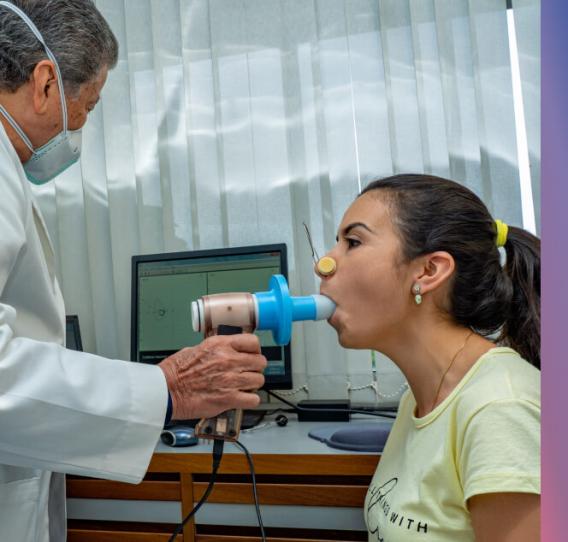The ongoing dilemma of phenotyping vs stepping up or down in asthma therapy
An expert commentary by Dr Sara Núñez Palomo
and Dr Miguel Román-Rodríguez, Spain
Despite recent advances in pharmacological asthma therapy, up to 45% of patients with asthma remain uncontrolled, even in developed European countries.1 This significantly impacts patients' quality of life and increases health costs.1
One of the reasons underpinning the poor levels of control of asthma could be the low importance that asthma management guidelines give to the heterogeneity of asthma.2 One attempt to address such heterogeneity has been the identification of different phenotypes, defined as specific clinical, demographic, or physiological characteristics that may or may not be associated with underlying disease mechanisms.
Some authors propose a change, from the classic concept of step up and down asthma treatment according to the degree of disease control, towards a new approach based on treatable traits (TT), biomarkers and the phenotyping and characterisation of each asthma patient, to drive more personalised treatment.2,3
However, classification into phenotypes also generates gaps due to the heterogeneity within each group and its variability over time.
In their review, Perez de Llano et al attempt to justify an alternative treatment proposal for patients with uncontrolled asthma based on:3
- identifying and addressing TT
- considering the possible side effects of high doses of inhaled corticosteroids (ICS)
- the inflammatory profile
- the optimal therapeutic objectives for each asthma patient

Different TTs and associated biomarker were identified as follows:3
| Treatable Trait (TT) | Biomarker or specific diagnostic test associated with TT |
| Bronchial obstruction | FEV1 |
| Low adherence to treatment | Questionnaires |
| Triggers (allergens, pollution) | Environmental levels |
| Allergy | Specific IgE |
| Smoking | CO-oximetry |
| Eosinophilia | Blood Eosinophils/ FeNO |
| Chronic infection | Germs (pathogen) Isolation |
Adapted from Llano L P, et al. 2021.3
In general, asthma guidelines recommendations do not reflect the significant differences between the various ICS formulations in terms of potency; Separation of efficacy and safety is not made and low and high dose categories are wrongly considered to inevitably correspond to low and high risk of systemic effects. However, not all ICS molecules are therapeutically similar.3
Some have been shown to provide more protection against airway hyperresponsiveness with less systemic activity (as measured by 24-hour plasma cortisol suppression) and therefore possess a broader therapeutic index (systemic activity/airway potency ratio). In addition, the effective dose depends not only on the molecule used but also on the inhaler device, particle size, and inhalation technique.3
The latest version of GINA equally recommends regular maintenance ICS and as needed ICS/formoterol to prevent exacerbations in step 2 patients, without considering different therapeutic goals between individual patients that could justify different treatment strategies.2 Moreover, generalising this recent therapeutic approach assumes that most step 2 patients have poor adherence to medication, something that has not been conclusively demonstrated.3
The authors also support a new therapeutic approach with the fact that substantial groups of patients with mild and moderate asthma have little evidence of T2-high inflammation and, by extension, are likely to show a poor response to ICS treatment.3
Identification of the T2-high inflammatory profile would therefore be of huge importance to drive pharmacological treatment.3 Biomarkers used routinely in clinical practice to identify T2-high asthma are:3
- blood eosinophils
- induced sputum cell count
- fraction of exhaled nitric oxide (FeNO)
- IgE
The main limitations are the imperfect balance of sensitivity and specificity of the biomarkers and the difficulty in establishing a cut-off point for each of them, mainly due to the impact of therapy on blood and sputum eosinophils and FeNO levels.3


Key takeaways:
- As biomarkers are more likely to reflect the inflammatory pattern of a given patient, it is possible that asthma management may move away from the current step up and down guidelines-based strategy.3
- Consequently, a new personalised approach, based on the specific treatment of TT could become routine clinical practice.3
ABBREVIATION:
FeNO, fraction of exhaled nitric oxide; FEV1, forced expiratory volume (in the first second); ICS, inhaled corticosteroids; IgE, immuno-globulin E; T2-high, type 2 high (subgroup); TT, treatable traits.
REFERENCES:
- Price D, et al. Asthma control and management in 8000 European patients: the REcognise Asthma and LInk to Symptoms and Experience (REALISE) survey. NPJ Prim Care Respir Med. 2014;24(1):14009. doi: 10.1038/npjpcrm.2014.9
- GINA 2022. https://ginasthma.org/wp-content/uploads/2022/05/GINA-Main-Report-2022-FINAL-22-05-03-WMS.pdf. Accessed 6 September 2022
- Llano L P, et al. Phenotype-Guided Asthma Therapy: An Alternative Approach to Guidelines. J Asthma Allergy. 2021;14:207-217. Published 2021 Mar 12. doi: 10.2147/JAA.S266999
Prescribing information for Flutiform (fluticasone propionate/formoterol)

Mundipharma brings you recent and clinically relevant publications in the evolving field of respiratory medicine recommended by an international panel of specialists and general practitioners.

Dr Sara Núñez Palomo

Dr Miguel Román-Rodríguez

Dr Sara Núñez Palomo













